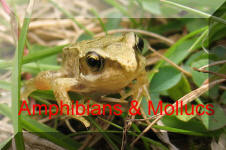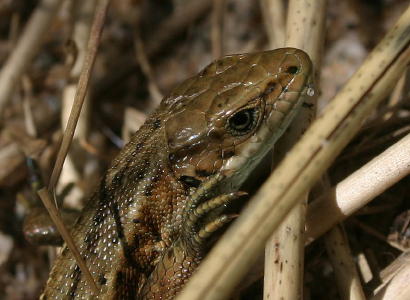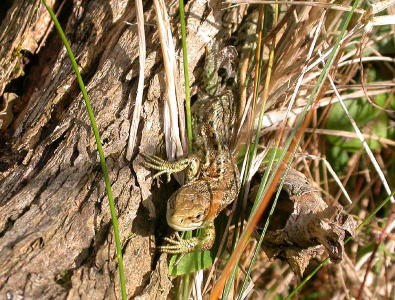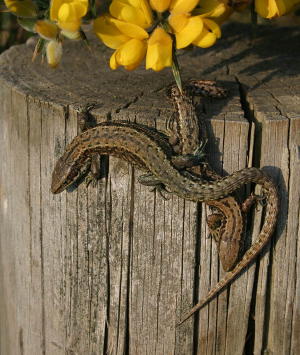Size: Approximately
10 to 15 cms (inc tail).
Distribution:
Found throughout the UK.
Months seen:
March to October.
Habitat / Ecology:
Grassland, heathland and sand dunes.Common
lizards prefer warm sheltered habitats with nearby dry places where they
can bask in the sunshine. In Wales they are often seen in and around dry
stone walls or along railway tracks, where they bask on the stone ballast
beside and between the tracks.
The majority of sightings have been on grassland, hedgerows, woodland edges,
road and railway embankments. Common lizards emerge from hibernation sometimes
as early as mid- February if the weather is mild. Initially they will spend
long periods basking and they start to mate in April and May. The males
are territorial and compete for the females, fights being commonplace.
Eggs are retained in the body and 4-10 live young are born under cover,
in late July or August in a membranous sac. The young lizard ruptures the
membrane with a special egg-tooth and is independent of the mother.
Diet: Small
insects and spiders.Common lizards eat a variety of insect and other invertebrate
species.
Description
Common lizards can be mistaken for newts but are
more alert and quick moving if disturbed. They also have a dry scaly skin.
Common lizards can reach a length of 18cm (7 inches) but this is rare and
most are much smaller. They are variable in colour ranging from brown or
yellow-brown to almost green. These green Common lizards should not be
confused with Sand lizards. Male Common lizards often have darker backs
with a broken striped pattern and a variable number of pale dots edged
with black called ocelli. They have yellow or orange bellies which are
spotted. with black markings. The female is paler, with a few scattered
ocelli and some females have a continuous stripe along the centre of the
back. The belly is pale yellow, usually lacking spots. The most reliable
method for distinguishing between the sexes is to look for the swelling
at the base of the tail in the male. Young Common lizards are very dark
coloured compared to the adults and have two rows of pale spots down their
back.
Special features:
The common lizard is also known as the Viviparous
Lizard. They can be found lying on stones or logs in the sunshine, because
they need the heat of the sun to warm their bodies. This makes them more
active, and able to hunt for their food. Common lizards are good swimmers.
Female common lizards are viviparous. This simply
means she retains fertilised eggs inside her body until they are almost
ready to hatch. This helps to keep the eggs warm. When the time is right
she lays the eggs, and within seconds the young lizards hatch out. The
smooth snake, the adder and the slow worm are also viviparous.
FAQS ?
Common lizards have an amazing way to escape capture
from predators. If caught by the tail, they simply snap it off at a joint
near the base, leaving the predator holding just the tail. The lizard can
grow a new tail... if it lives long enough.
Protection status
Some protection under the Berne Convention as to
their exploitation.
Protected under the Wildlife and Countryside Act
1981 Schedule 5. from trade, injury and killing




